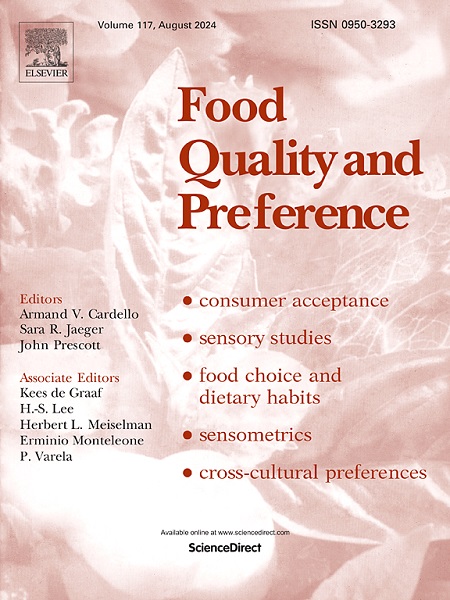Unpacking healthy eating: An application of the model of goal-directed behavior
IF 4.9
1区 农林科学
Q1 FOOD SCIENCE & TECHNOLOGY
引用次数: 0
Abstract
This research investigates the psychological and social drivers of healthy eating intentions and behavior using the Model of Goal-Directed Behavior (MGB), an extension of the Theory of Planned Behavior (TPB). The MGB integrates affective (anticipated emotions), habitual (past behavior), and motivational (desire) factors, offering greater predictive power compared to the TPB. This research also examines the influence of cooking for self-consumption on perceived behavioral control over healthy eating. Data were collected from 369 adults via an online survey, with 141 participants completing a follow-up survey one month later to report actual eating behavior. Results indicate that anticipated emotions and subjective norms are key predictors of healthy eating desire, while attitudes show no significant effect. Desire predicts intentions, which, in turn, drive behavior. Notably, the self-efficacy component of perceived behavioral control moderates the desire-intention relationship, challenging traditional MGB assumptions. Additionally, cooking for self-consumption enhances both internal and external factors that shape perceived behavioral control. This research contributes to the prevailing debate on the role of affect versus attitudes in shaping food consumption behaviors, highlighting the dominant role of anticipated emotions over attitudes in driving healthy eating intentions, even when accounting for past behavior and subjective norms. The research also refines and extends the MGB by incorporating food preparation as an antecedent of perceived behavioral control, suggesting a novel mechanism for fostering control over healthy eating. The findings offer practical insights for designing interventions and programs that leverage emotions, subjective norms, and perceived behavioral control to promote healthier eating behavior.
打开健康饮食的包装:目标导向行为模型的应用
本研究运用计划行为理论(TPB)的延伸——目标导向行为模型(MGB),探讨健康饮食意图和行为的心理和社会驱动因素。MGB整合了情感(预期情绪)、习惯(过去行为)和动机(欲望)因素,与TPB相比具有更强的预测能力。这项研究还考察了自我消费烹饪对感知行为控制对健康饮食的影响。研究人员通过一项在线调查收集了369名成年人的数据,其中141名参与者在一个月后完成了一项后续调查,报告了他们的实际饮食行为。结果表明,预期情绪和主观规范是健康饮食欲望的主要预测因子,而态度对健康饮食欲望的影响不显著。欲望能预测意图,而意图又能驱动行为。值得注意的是,感知行为控制的自我效能成分调节了欲望-意图关系,挑战了传统的MGB假设。此外,为自我消费而烹饪增强了塑造感知行为控制的内部和外部因素。这项研究有助于对影响和态度在塑造食物消费行为中的作用的普遍争论,突出了预期情绪在推动健康饮食意图方面的主导作用,即使在考虑过去的行为和主观规范时也是如此。该研究还通过将食物准备作为感知行为控制的前项来完善和扩展MGB,提出了一种促进对健康饮食控制的新机制。这些发现为设计干预措施和计划提供了实用的见解,这些干预措施和计划利用情绪、主观规范和感知行为控制来促进更健康的饮食行为。
本文章由计算机程序翻译,如有差异,请以英文原文为准。
求助全文
约1分钟内获得全文
求助全文
来源期刊

Food Quality and Preference
工程技术-食品科技
CiteScore
10.40
自引率
15.10%
发文量
263
审稿时长
38 days
期刊介绍:
Food Quality and Preference is a journal devoted to sensory, consumer and behavioural research in food and non-food products. It publishes original research, critical reviews, and short communications in sensory and consumer science, and sensometrics. In addition, the journal publishes special invited issues on important timely topics and from relevant conferences. These are aimed at bridging the gap between research and application, bringing together authors and readers in consumer and market research, sensory science, sensometrics and sensory evaluation, nutrition and food choice, as well as food research, product development and sensory quality assurance. Submissions to Food Quality and Preference are limited to papers that include some form of human measurement; papers that are limited to physical/chemical measures or the routine application of sensory, consumer or econometric analysis will not be considered unless they specifically make a novel scientific contribution in line with the journal''s coverage as outlined below.
 求助内容:
求助内容: 应助结果提醒方式:
应助结果提醒方式:


